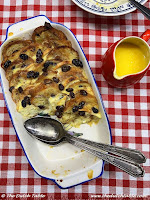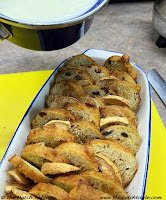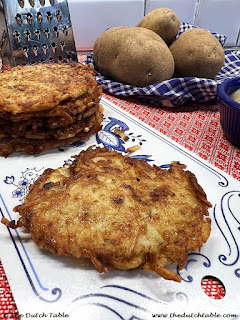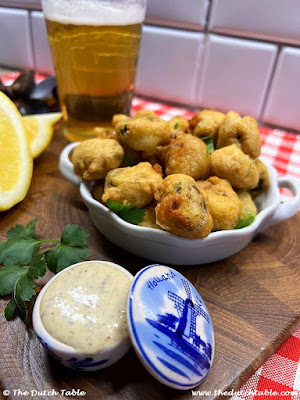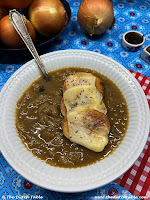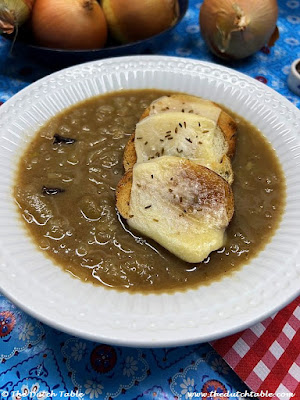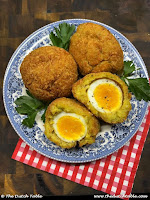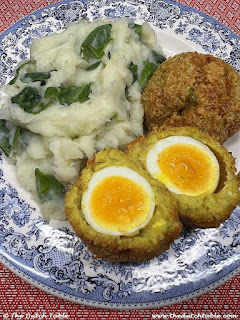Eierbal (egg ball), or
aaierbal in the Groningen dialect, is a treat like no other. It's similar in looks to the Scotch egg, but whereas a Scotch egg has a wrapping of ground meat or sausage, the
eierbal has a thick gravy coat, seasoned with curry spices and fresh parsley. Both contain a whole boiled egg, and both are breadcrumbed and deep-fried until they're golden and crispy, but where the Scotch egg gives a solid bite, the
eierbal is creamier, much like a
bitterbal or a
kroket. The egg in the Gronings specialty is also soft boiled so that the yolk is still a little liquid. Heaven!
Contrary to other snacks, like the frikandel, the eierbal can not be found everywhere and seems to be specific to Groningen and surrounding areas. There is one place, in Venlo, Limburg, that claims to have been the originator of the treat, but the proprietor lived in Groningen for a while so possibly got her inspiration there.
So how did this deep-fried egg ball happen to be in Groningen? I am glad you asked! During WW1, the Netherlands was neutral and provided a safe location for many English soldiers who were fleeing from the Germans in Belgium. They were interned in a camp in Groningen, named Timbertown. Up to 1,500 soldiers were housed here at one time.
As the war progressed, the men became restless but as they were unable to leave the camp, they entertained themselves with theatre, music and....food! A couple of lads opened up a chip shop on the premises. They named it the Timbertown Chip Shop, and were open every night from 4 PM - 8 PM.
It is very, very possible that these men also made Scotch eggs, seeing as how the Scotch egg was already known for several centuries in England. As they were also in contact with the locals, it is easy to see how the idea of wrapping boiled eggs would have stuck.
Since then, the eierbal has nestled itself so deeply into the local tradition and culture, that the golden snack was added to the inventory of Immaterial Cultural Heritages in 2017. As it appears to have been around since the early 1900s until now, you can imagine that the recipe has developed: almost everybody has a favorite snackbar to get their eierbal fix, or makes the recipe slightly different, but they're all considered eierballen, and they're all considered a Groningen tradition.
I decided to make these after working on videos from Groningen for our YouTube channel. Many of you have commented on how much you enjoy the nostalgic throwbacks to older times, and see how our parents and grandparents lived. I was also making dinner at the time and decided to serve mine as a meat alternative with spinach stamppot. Not traditional, but delicious nonetheless!
I chose to make the most traditional version, those with a curry ragout, but if you're making kroketten or bitterballen one of these days, you may try it also with a meaty ragout to see if you like it or substitute the curry powder with Mediterranean herbs, or something else you favor. I can also see where falafel seasoning would go well. You can also brush the egg with flavorings (sweet chili sauce, or mustard), so this recipe is perfect for turning it into a family exclusive!
Groningse Eierbal
4 eggs
3 1/2 tablespoons butter (50 grams)
1/2 cup flour (100 grams)
2 cups vegetable or chicken bouillon (450 ml)
2 1/2 teaspoons curry powder
2 tablespoons chopped fresh parsley
1 egg
1 cup breadcrumbs or panko (50 grams)
2 tablespoons flour
Oil for frying
Melt the butter in a skillet and stir in the flour, until it looks like wet sand. Slowly stir in the bouillon until you have a thick sauce, about four minutes. Add the curry powder and the parsley (or other flavors) and keep stirring for another two more minutes. Line a shallow pan with plastic film, pour the ragout sauce over it, and tap another piece of plastic on top, touching the sauce. This will keep it from drying out. Chill the ragout overnight, or for at least four hours, until solid.
Boil 4 eggs for 5 minutes, then shock in cold water and peel. Divide the cold ragout into four pieces, and wrap each piece around an egg, shaping it into a round ball. This does not have to be precise, so do the best you can! Roll the wrapped eggs in a little bit of flour. Beat the 5th egg, and roll each egg in the egg wash, let the egg drip off a little bit, and then roll it in breadcrumbs or panko. Pat together and shape into a ball again. If you want, you can repeat the egg and breadcrumbing for a thicker coating. If you feel that these are too big, or want more of a small snack, boil the eggs one minute longer, and cut in half before wrapping.
Heat the fryer to 350F (170C) and carefully drop the
eierballen in the fryer, one or two at a time. All at once may overflow the fryer, or drop the temperature too fast. Fry for five to six minutes, or until all sides are golden brown. Drain on a tray with kitchen towels to soak up some of the grease. Serve cut in half, cold or hot.
Sources: Sikkom, Friends
